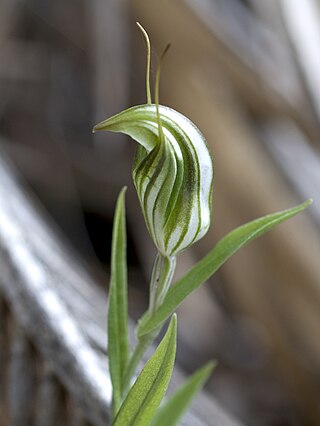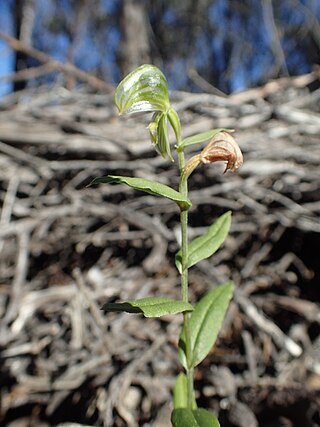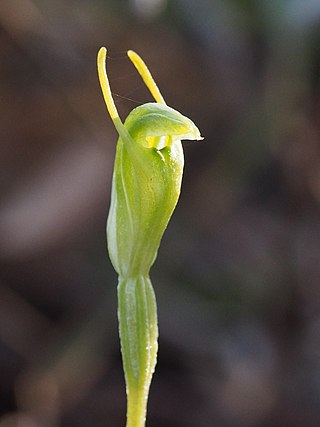
Pterostylis hamiltonii, commonly known as the red-veined shell orchid, is a species of orchid endemic to the south-west of Western Australia. As with similar orchids, the flowering plants differ from those which are not flowering. The non-flowering plants have a rosette of leaves but the flowering plants lack a rosette and have a single flower with leaves on the flowering spike. This greenhood has a green and white, striped flower with reddish-brown markings and forms colonies, sometimes of thousands of plants.

Pterostylis nana, commonly known as the dwarf snail orchid, is a species of orchid endemic to Australia. It has a rosette of leaves at it base and a single narrow, bright green and white flower with a small labellum. There is uncertainty about its classification - some sources include South Australia and Western Australia in its range.

Pterostylis scabra, commonly known as the green-veined shell orchid, is a species of orchid endemic to the south-west of Western Australia. As with similar orchids, the flowering plants differ from those which are not flowering. The non-flowering plants have a rosette of leaves but the flowering plants lack a rosette and have a single flower with leaves on the flowering spike. This greenhood has a white flower with green and pale brownish-fawn stripes and a long, curved protruding labellum. It is found in inland areas between Kalbarri and Esperance.
Pterostylis angusta, commonly known as the narrow shell orchid, is a species of orchid endemic to the south-west of Western Australia. As with similar greenhoods, the flowering plants differ from those which are not flowering. The non-flowering plants have a rosette of leaves flat on the ground but the flowering plants have a single flower with leaves on the flowering spike. In this species the flower is green, white and brown with an inflated base, a narrow hood and the longest labellum of any Western Australian Pterostylis species.
Pterostylis aspera, commonly known as the rough shell orchid, is a species of orchid endemic to the south-west of Western Australia. As with similar greenhoods, the flowering plants differ from those which are not flowering. The non-flowering plants have a rosette of leaves flat on the ground but the flowering plants have a single flower with leaves on the flowering spike. In this common species, the flower is white with green and reddish-brown stripes and a short, straight labellum.
Pterostylis dilatata, commonly known as the robust snail orchid, is a species of orchid which is endemic to the south-west of Western Australia. Non-flowering plants have a rosette of leaves but flowering plants lack a rosette and have a single green and white flower on a flowering stem with stem leaves. The flowers appear in winter and have lateral sepals which almost close off the front of the flower.

Pterostylis leptochila, commonly known as the Ravensthorpe rufous greenhood or narrow-lipped rustyhood is a plant in the orchid family Orchidaceae and is endemic to the south-west of Western Australia. Both flowering and non-flowering plants have a relatively large rosette of leaves. Flowering plants also have up to five large translucent white flowers with olive green and brown lines and markings and a narrow, insect-like labellum.

Pterostylis microphylla, commonly known as the small rosette snail orchid, is a species of orchid endemic to the south-west of Western Australia. As with similar greenhoods, the flowering plants differ from those which are not flowering. The non-flowering plants have a rosette of leaves flat on the ground but the flowering plants have a single flower with leaves on the flowering spike. In this species, the flower is white and green with narrow, erect lateral sepals and a small labellum.
Pterostylis parva, commonly known as the fawn snail orchid, is a species of orchid endemic to the south-west of Western Australia. As with similar greenhoods, the flowering plants differ from those which are not flowering. The non-flowering plants have a small rosette of leaves flat on the ground but the flowering plants have a single flower with leaves on the flowering spike. In this species, the flower is small, fawn, green and white and is similar to P. timothyi but smaller in stature.
Pterostylis platypetala, commonly known as the broad-petalled snail orchid, is a species of orchid endemic to the south-west of Western Australia. It has a rosette of leaves and when flowering, a single green and white flower with relatively wide petals. In ideal conditions it can form colonies of hundreds of plants and often grows under melaleucas on the edge of winter-wet areas.
Pterostylis brevichila, commonly known as the dwarf shell orchid, is a species of orchid endemic to the south-west of Western Australia. As with similar greenhoods, the flowering plants differ from those which are not flowering. The non-flowering plants have a rosette of leaves flat on the ground but the flowering plants have a single flower with leaves on the flowering spike. In this species, the flower is small and white with brown stripes and is similar to P. aspera but smaller in stature.
Pterostylis brunneola, commonly known as the giant snail orchid, is a species of orchid endemic to the south-west of Western Australia. Both flowering and non-flowering plants have a large rosette of leaves flat on the ground and flowering plants have a single distinctive white flower with pale fawn stripes and have leaves on the flowering spike. This species often forms large colonies, sometimes with Caladenia species.

Pterostylis echinulata, commonly known as the hairy-leafed snail orchid, is a species of orchid endemic to the south-west of Western Australia. Both flowering and non-flowering plants have a compact rosette of leaves flat on the ground and flowering plants have a single pale yellowish-green flower.
Pterostylis erubescens, commonly known as the red sepaled snail orchid, is a species of orchid endemic to the south-west of Western Australia. Non-flowering plants have a rosette of leaves flat on the ground but flowering plants lack a rosette and have a single large green flower which turns reddish-brown as it ages, and has leaves on the flowering spike.

Pterostylis exserta, commonly known as the exserted rufous greenhood, is a species of orchid endemic to the south-west of Western Australia. Both flowering and non-flowering plants have a large rosette of leaves flat on the ground and flowering plants have up to seven pale, transparent green and white flowers with brownish lines.

Pterostylis glebosa, commonly known as the clubbed snail orchid, is a species of orchid endemic to the south-west of Western Australia. Non-flowering plants have a rosette of leaves flat on the ground but flowering plants usually lack a rosette and have a single green and white flower with club-like lateral sepals. It sometimes forms colonies of thousands of plants.

Pterostylis karri, commonly known as the karri snail orchid, is a species of orchid endemic to the south-west of Western Australia. Both flowering and non-flowering plants usually have a small rosette of leaves and flowering plants have a single green and white flower with unusually long, erect lateral sepals. Like some similar greenhoods, it often forms dense colonies.

Pterostylis lortensis, commonly known as the Lort River snail orchid, is a species of orchid endemic to the south-west of Western Australia. Non-flowering plants have a rosette of leaves flat on the ground but flowering plants usually lack a rosette and have a flowering stem with leaves and a single pale green and white flower with narrow, club-like lateral sepals.
Pterostylis microglossa, commonly known as the Kalbarri shell orchid, is a species of orchid endemic to the south-west of Western Australia. Non-flowering plants have a rosette of leaves flat on the ground but flowering plants lack a rosette and have a flowering stem with leaves and a single green, white and brownish-red flower.

Pterostylis brevisepala, commonly known as short-eared snail orchid, is a species of orchid endemic to the south-west of Western Australia. It has a loose rosette of leaves at the base of the plant, and a single green and white flower.











